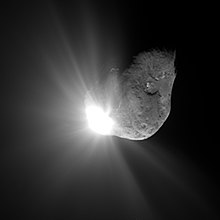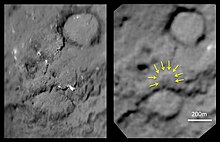Tempel 1
[10] Photographic attempts during 1898 and 1905 failed to recover the comet, and astronomers surmised that it had disintegrated, when in reality, its orbit had changed.
Perihelion also changed, increasing by 50 million kilometres, to 2.1 AU, rendering the comet far less visible from Earth.
[11] Tempel 1 was rediscovered in 1967 (as 9P/1967 L1, 1966 VII) after British astronomer Brian G. Marsden performed precise calculations of the comet's orbit that took into account Jupiter's perturbations.
[2] Initial inspection revealed nothing, but in late 1968 she found a June 8, 1967 exposure (Tempel 1 had passed perihelion in January) that held the image of an 18th magnitude diffuse object very close to where Marsden had predicted the comet to be.
[12] On 4 July 2005 at 05:52 UTC (01:52 EDT), Tempel 1 was deliberately struck by one component of the NASA Deep Impact probe, one day before perihelion.
Spitzer Space Telescope observations of the ejecta detected dust particles finer than human hair and discovered the presence of silicates, carbonates, smectite, metal sulfides (such as fool's gold), amorphous carbon and polycyclic aromatic hydrocarbons.
[18] In part, because the crater formed during the Deep Impact collision could not be imaged during the initial flyby,[16] on 3 July 2007, NASA approved the New Exploration of Tempel 1 (or NExT) mission.
[21] The geometry of the flyby allowed investigators to obtain considerably more three-dimensional information about the nucleus from stereo pairs of images than during Deep Impact's encounter.
[22] Scientists were able to quickly spot locations where an elevated flow-like formation of icy material on the comet's surface receded due to sublimation between encounters.
[4] Then, as a Jupiter-family comet, it will spend years interacting with the giant planet Jupiter, and by October 2084 perihelion will be lifted as high as 1.98 AU.


Deep Impact 1 Tempel 1 Earth 103P/Hartley



Stardust · 81P/Wild · Earth · 5535 Annefrank · Tempel 1
